![]()
![]()
![]()
Use LEFT and RIGHT arrow keys to navigate between flashcards;
Use UP and DOWN arrow keys to flip the card;
H to show hint;
A reads text to speech;
68 Cards in this Set
- Front
- Back
|
Customer Insights |
Fresh understandings of customers and the marketplace derived from marketing information that become the basis for creating customer value and relationships. |
|
|
Marketing Information System (MIS) |
People and procedures dedicated to assessing information needs, developing the needed information, and helping decision makers to use the information to generate and validate Actionable customer and market insights. |
|
|
Internal Databases |
Electronic collections of consumer and market information obtained from data sources within the company network. |
|
|
Competitive Marketing Intelligence |
The systematic collection and analysis of publicly available information about consumers, competitors, and developments in the marketing environment. |
|
|
Marketing Information System Diagram |
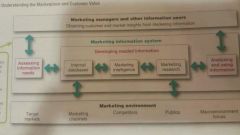
|
|
|
Marketing Research |
The systematic design, collecti9n, analysis, and reporting of data relevant to a specific marketing situation facing an organization. |
|
|
The Marketing Research Process (Diagram) |
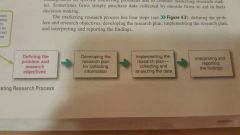
|
|
|
Exploratory Research |
Marketing research to gather preliminary information that will help define problems and suggest hypothesis. |
|
|
Descriptive Research |
Marketing research to better describe marketing problems, situations, or markets such as the market potential for a product or the demographics and attitudes of consumers. |
|
|
Casual Research |
Marketing research to test hypothesis about cause-and-effect relationships. |
|
|
Secondary Data |
Information thay already exists somewhere, having been collected for another purpose. |
|
|
Primary Data |
Information collected for the specific purpose at hand. |
|
|
Observational Research |
Gathering primary Data by observing relevant people, actions, and situations. |
|
|
Ethnographic Research |
A form of observational research that involves sending trained observers to watch and interact with customers in their natural environments |
|
|
Survey Research |
Gathering primary data by asking people questions about their knowledge attitudes preferences and buying behavior |
|
|
Experimental Research |
Bring primary data by selecting match groups of subjects giving them different treatments controlling related factors and checking for differences in group responses. |
|
|
Focus group interviewing |
Personal interviewing that involves inviting 6 to 10 people together for a few hours with a trained interviewer to talk about a product, service, or organization. The interviewer focus is the group discussion on important issues. |
|
|
Planning Primary Data Collection |
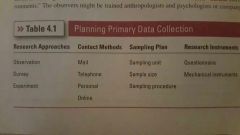
|
|
|
Strengths and weaknesses of Contact Methods |
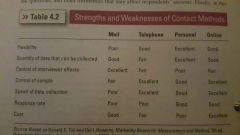
|
|
|
Online marketing research |
Collecting primary data online through internet service, online focus groups, web-based experience, or track and consumers online behavior. |
|
|
Online focus groups |
Gathering a small group of people online with the train to moderator to chat about a product, service, or organization and gain qualitative insights about consumer attitudes and behavior. |
|
|
Behavioral targeting |
Using online consumer tracking data to target advertisements and marketing offers to specific customers. |
|
|
Sample |
A segment of the population selected for marketing research to represent the population as a hole. |
|
|
Types of Samples |
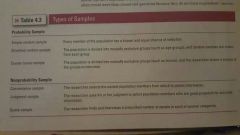
|
|
|
Customer relationship management (CRM) |
Managing detailed information about individual customers and carefully managing customer touch points to maximize customer loyalty. |
|
|
Price |
The amount of money charged for product or service, or the sum of the values that customers exchange for the benefits of having or using the product or service. |
|
|
Customer value - based pricing |
Setting price based on buyers perceptions of value rather than on the sellers cost. |
|
|
Considerations in setting price |

|
|
|
Cost-based Pricing v. Value-based Pricing (diagram) |
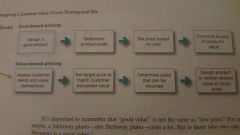
|
|
|
Good - value pricing |
Offering just the right combination of quality and good service at a fair price. |
|
|
Value - added pricing |
Attaching value - added features and services to differentiate a company's offers and charging higher prices. |
|
|
Cost - based pricing |
Setting prices based on the cost of producing, distributing, and selling the product plus a fair rate of return for effort and risk. |
|
|
Fixed costs (overhead) |
Cost that do not vary with production or sales level. |
|
|
Variable costs |
Costs that vary directly with the level of production. |
|
|
Total cost |
The sum of the fixed and variable costs for any given level of production. |
|
|
Cost-plus pricing (markup pricing) |
Adding a standard markup to the cost of the product. |
|
|
Break - even pricing (target return pricing) |
Setting price to break even on the costs of making and marketing a product, or setting price to make a target return. |
|
|
Competition - based pricing |
Setting prices based on competitors strategies, prices, costs, and market offers |
|
|
Break - even chart for determining target return price and break - even volume (diagram) |
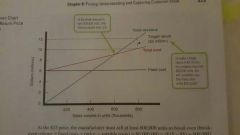
|
|
|
Target costing |
Pricing that starts with an ideal selling price, then targets costs that will ensure that the price is met. |
|
|
Demand curve |
Curve that shows the number of units the market will buy in a given time period, at different prices that might be charged. |
|
|
Price elasticity |
A measure of the sensitivity of demand to changes in price. The more inelastic the smaller the change in demand for the change in price. The more elastic, the greater the change in demand with a change in price. |
|
|
Market - skimming pricing (price skimming) |
Setting a high price for a new product to skim maximum revenues layer by layer from the segments willing to pay the high price; the company makes fewer but more profitable sales. |
|
|
Market - penetration pricing |
Setting a low price for a new product in order to attract a large number of buyers in a large market share. |
|
|
Product line pricing |
Setting the price steps between various products in a product line based on cost differences between the products customer evaluations of different features and competitors prices. |
|
|
Optional - product pricing |
The pricing of optional or accessory products along with a main product. |
|
|
Captive - product pricing |
Setting a price for products that must be used along with the main product, such as blades for a razor and games for a video - game console. |
|
|
By - product pricing |
Setting a price for by product in order to make the main products price more competitive. |
|
|
Product bundle pricing |
Combining several products and offering the bundle at a reduced price. |
|
|
Discount |
A straight reduction in price on purchases during a stated period of time and larger quantities. |
|
|
Allowance |
Promotional money paid by manufacturers to retailers in return for an agreement to feature the manufacturer's products in some way. |
|
|
Segmented pricing |
Selling a product or service at two or more prices, where the difference is in price is not based on differences in costs. |
|
|
Psychological pricing |
Pricing that considers the psychology of prices and not simply the economics the price is used to say something about the product. |
|
|
Reference prices |
Crisis that buyers carry in their minds and refer to when they look at a given product. |
|
|
Promotional pricing |
Temporarily pricing products below the list price, and sometimes even below cost, to increase short-run sales. |
|
|
Dynamic pricing |
Adjusting prices to continually to meet the characteristics and needs of individual customers and situations. |
|
|
Promotion mix or marketing communications mix |
Specific blend of promotion tools that the Company uses to engage customers, persuasively communicate customer value, and build customer relationships. |
|
|
Advertising |
Any paid form of non personal presentation and promotion of ideas, goods, or services by an identified sponsor. |
|
|
Sales promotion |
Short - term incentives to encourage the purchase or sale of a product or service. |
|
|
Personal selling |
Personal customer interactions by the firm sales force for the purpose of making sales and building customer relationships |
|
|
Public relations |
Building good relations with the company's various public by obtaining favorable publicity, building up a good corporate image, and handling or heading off unfavorable rumors, stories, and events. |
|
|
Direct and social - media marketing |
Engaging and interacting directly with carefully targeted individual customers and consumer communities to both obtain an immediate response and cultivate lasting customer relationships. |
|
|
Brand content management |
Creating, inspiring, and sharing brand messages and conversations with and among consumers across a fluid mix of paid, owned, earned, and shared channels. |
|
|
Integrated marketing communications |
Carefully integrating in coordinating the company's many communication channels to deliver a clear, consistent, and compelling message about the organization and its products. |
|
|
Push strategy |
Promotion strategy that calls for using the sales force and trade promotion to put the product through channels. The producer promotes the product to channel members, which in turn promote it to final consumers. |
|
|
Pull strategy |
A promotion strategy that calls for spending a lot of consumer advertising and promotion to induce final consumers to buy the product, creating Adam and vacuum that pulls the product through the channel. |
|
|
Advertising budget |
The dollars and other resources allocated to a product or company advertising program. |
|
|
Advertising objective |
Pacific communication task to be accomplished with a specific target audience during a specific period of time. |

